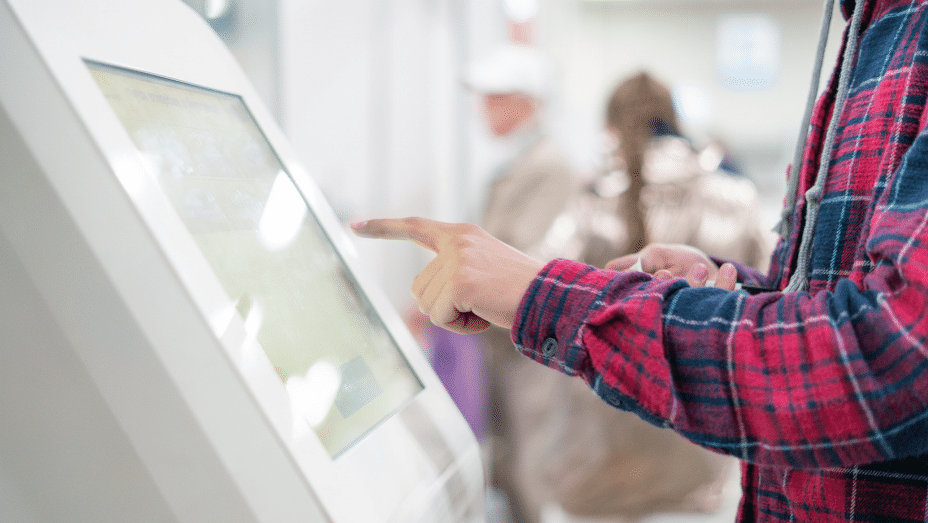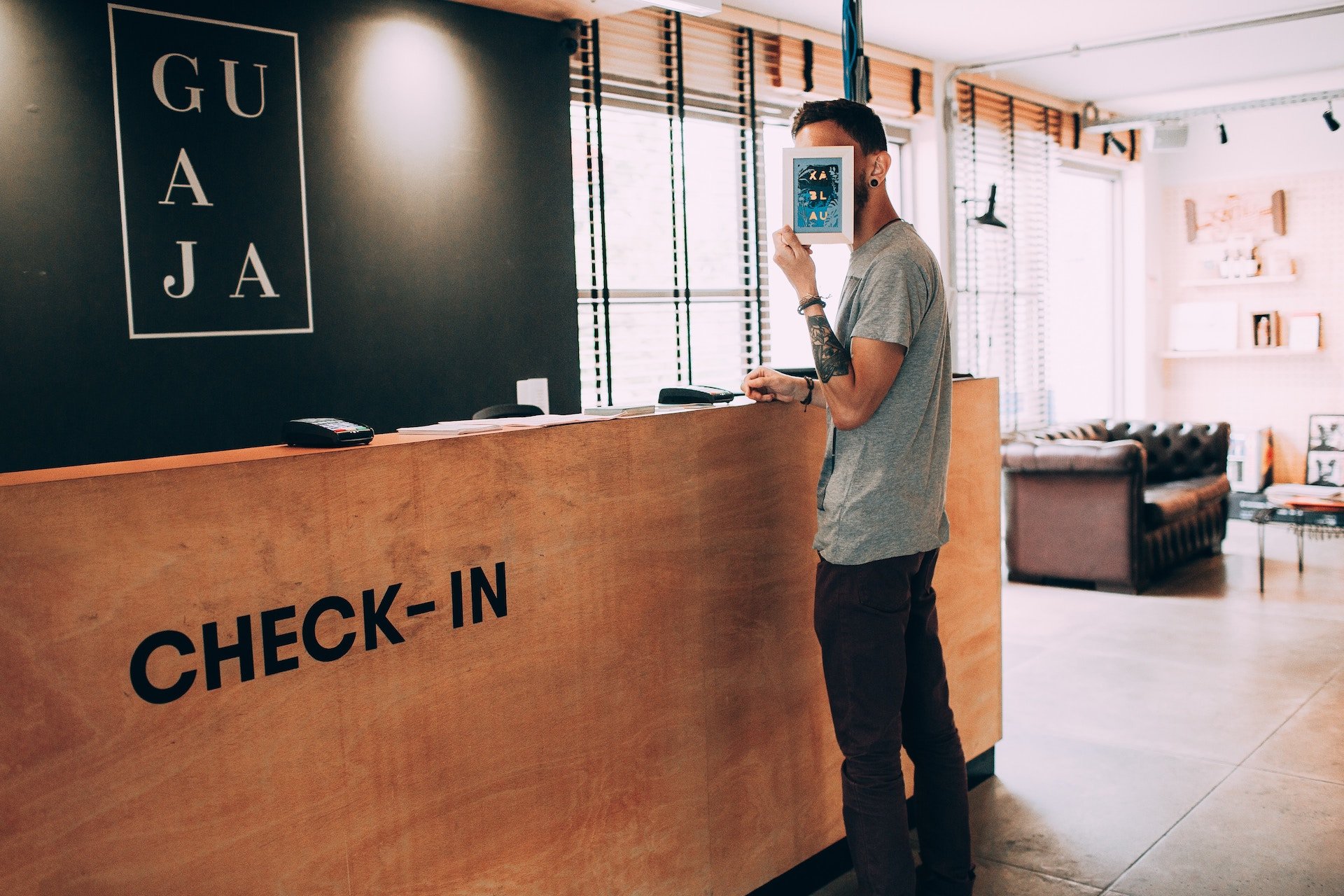Wouldn't it be incredible to eliminate all those dreaded long queues at your reception desk, relieve your front-office staff from the constant stress, and greet every visitor with an efficient, tech-savvy welcome?
Let us introduce you to a visitor check-in system – the revolutionized approach to streamline your office's guest management. This comprehensive guide will take you on a profound journey through visitor check-in systems. Dive right in!
TL;DR:
- Visitor check-in systems streamline entry into facilities using digital methods, enhancing security and efficiency.
- They are crucial for security, efficiency, and compliance in various industries.
- Technology has replaced paper logs with digital solutions for better efficiency and security.
- The typical visitor check-in process involves pre-registration, check-in, badge printing, tracking, and check-out.
- Automation improves efficiency, security, and visitor experiences.
- Automated systems reduce errors and comply with data protection regulations.
- Self-service kiosks, user-friendly interfaces, visitor registration, customization, reporting, badge printing, QR code/barcode scanning, and integration with access control are key features of a modern visitor check-in system.
- Consider scalability, customization, data privacy, compliance, and cost-effectiveness when choosing a visitor check-in system.
Defining Visitor Check-in Systems
Visitor check-in systems are tools designed to streamline and secure the entry of individuals into a facility or premises, such as offices, schools, hospitals, or events. These systems have become increasingly essential in today's security-conscious and digitally-driven world, replacing traditional paper logs with digital registration methods.
By employing technologies like self-service kiosks, mobile apps, or web-based interfaces, visitor check-in systems not only enhance the efficiency of the check-in process but also help maintain a comprehensive record of visitors. This gives organizations better control over who enters their premises, improves security, and simplifies the visitor experience.
Additionally, these systems often offer features like badge printing, real-time notifications, and integration with access control systems, making them invaluable tools for modern facilities and visitor management.
Understanding the Importance of an Efficient Visitor Check-in System
Recognizing the significance of an efficient visitor check-in system is pivotal in today's security-conscious and digitally-driven landscape. Such systems play a fundamental role in ensuring individuals' seamless and secure entry into various facilities and organizations. Not only do they eliminate the cumbersome paperwork of traditional sign-in methods, but they also offer a streamlined and user-friendly experience for visitors.
Beyond convenience, these systems enhance security by providing real-time information about who is on-site and submitting immediate notifications for authorized personnel. Moreover, they facilitate the creation of detailed visitor records, which are crucial for compliance and emergency response. An efficient visitor check-in system is the linchpin for modern visitor management, enhancing efficiency, security, and overall professionalism across diverse industries and institutions.

The Role of Technology in Modernizing Visitor Management Processes
Once upon a time (not so long ago), offices relied heavily on paper logbooks as their primary visitor logging software. This was slow and inefficient, often leading to misplaced information or illegibility issues.
By embracing technology in the form of digital visitor management systems, we have now entered an era of easy registration processes using self-service kiosks and visitor management apps. These guarantee quicker check-ins and improve security by integrating with existing office access control systems.
Sophisticated technologies like facial recognition, NFC, and AI are also making their place in the latest trends of visitor check-in software, leading towards a system that not just records but recognizes each guest.
Realizing how technology has modernized visitor management processes is the first step to understanding why your company needs to upgrade from those paper logbooks today! Let's move forward and get into how these systems function.
How Visitor Check-In Systems Work
Now that we've understood what a visitor check-in system is and its role, let's delve deeper into how it functions. The process might vary depending on the specific system employed; however, the basic steps usually remain similar.
Step-by-step Process of a Typical Visitor Check-In System
Visitor experiences often (but not always) begin online even before they step foot in your premises. Here's an overview of a typical visitor check-in workflow:
- Step1: Pre-Registration: Often, visitors are pre-registered for appointments or events through an application interface or via integration with calendar systems. They might receive email confirmation and details like meeting time, place, host contact, etc.
- Step 2: Arrival & Check-in: On arrival at the location, the visitor approaches front desk personnel operating the visitor management software or directly interacts with a self-service kiosk or tablet loaded with the same software for visitor management. Their identification detail is entered into the system - this could involve manual data entry or scanning driver's license/ID cards/passports.
- Step 3: Digital Badge Issue: Post verification of details, badges or access cards consisting their information and photo ID (captured then and there or fetched from IDs) are printed. Dedicated digital badge printers are commonly part of these systems.
- Step 4: Tracking & Real-Time Notifications: Hosts get notified about arrivals in real-time easing coordination while office managers can track guest movements if required.
- Step 5: Check-Out: Ideally, upon departure visitors should manually check out though automated solutions are also available using location technologies like Wi-Fi/GeoFencing.
- Step 6: Data Logging: All relevant visitor data is logged and stored securely for possible future reference.
The Benefits Of Automating The Visitor Check-In Process
Automation brings numerous benefits to any business process, and visitor management is not an exception. Here are some advantages of implementing an automated visitor check-in system:
- Time-Efficiency: Automation eliminates redundant manual tasks, resulting in faster check-ins and boosting operational efficiency.
- Enhanced Perception: A sleek, seamless visitor journey impresses them and reflects well on your brand image.
- Personalized Experiences: The system stores visitor history, enabling personalized experiences on subsequent visits.
- Confidentiality Maintained: Avoids the risk associated with openly visible paper logs that might reveal confidential information about who met whom and when.
Ensuring Data Accuracy And Security In Visitor Information
Accurate data collection is crucial because it directly affects security and helps avoid future complications. Automated systems are precious as they reduce the common human errors often seen in manual data entry.
Furthermore, following regulations like GDPR, which can vary by location, is essential when handling visitor data. Many office visitor management systems ensure privacy by taking sensitive data correctly and storing it lawfully. Additionally, cloud-based solutions strengthen data security by using advanced encryption techniques, which prevent unauthorized access to sensitive information.
A reliable digital visitor management system empowers businesses to simplify administrative tasks with precise data and protects personal information according to modern technology standards and legal requirements.

Key Features and Components of Visitor Check-In Software
Visitor check-in systems encompass several key features and components to manage and secure visitor access to a facility effectively. These typically include:
- Self-service kiosks or tablets
- A user-friendly interface
- Visitor registration
- Compliance features & visitor screening
- Customization capabilities
- Reporting & analytics
- Badge printing
- QR code or barcode scanner
- Integration with access control systems
Let’s discuss them one by one.
Self-Service Kiosks or Tablets
Convenient self-service kiosks or tablets have become essential to office visitor check-in systems due to their ability to streamline and enhance the visitor registration process. These interactive devices allow visitors to self-register, input their information, and print badges or notify their hosts without human intervention. This saves time and reduces the reception staff's workload, enabling them to focus on more critical tasks.
A User-Friendly Interface
A modern visitor check-in system must have a user-friendly interface because it serves as visitors' first point of contact and sets the tone for their experience. It ensures visitors can quickly and easily navigate the check-in process, reducing frustration and minimizing potential errors. It also caters to diverse users, including those who may not be tech-savvy, making the system accessible to all. An intuitive UI expedites the check-in process and leaves visitors with a positive impression of the organization, reflecting its commitment to a seamless and welcoming experience.
Visitor Registration
Visitor registration functionality is pivotal in enhancing security, streamlining operations, and maintaining organizational accountability. By requiring visitors to register, the visitor check-in solution, such as YAROOMS, captures crucial information about who is on the premises, when they arrived, and their purpose for the visit. This data is invaluable for security purposes, helping to monitor and track visitor activity, conduct background checks if necessary, and respond swiftly to any security issues or emergencies. Moreover, visitor registration enables better visitor management and resource allocation, allowing hosts to anticipate arrivals, prepare for meetings, and ensure a warm and organized welcome.
Compliance Features & Visitor Screening
Visitor check-in systems must enable compliance and visitor screening for several reasons. Firstly, compliance with security and safety regulations is paramount in many industries, such as healthcare, education, and corporate environments. A robust check-in system ensures that only authorized individuals gain access, crucial for maintaining a secure and compliant environment. Additionally, visitor screening helps identify potential risks by vetting individuals against watchlists or other security databases.
YAROOMS, for example, empowers office managers to achieve compliance by offering a customizable visitor screening questionnaire feature. This tool allows office managers to add specific questions tailored to their organization's needs, ensuring that all visitors are screened according to their unique requirements, ultimately enhancing security and regulatory compliance.
Customization Capabilities
Customizing your visitor check-in system is crucial for several reasons. Firstly, organizations can tailor the check-in process to their unique requirements and security protocols. This flexibility ensures the system aligns with specific compliance needs and security measures. Additionally, customization enhances the visitor experience by making it more user-friendly and efficient. Furthermore, branding is essential for many organizations, and a customizable check-in system can be personalized to match the company's visual identity, creating a cohesive and professional image for visitors. YAROOMS visitor check-in system offers rich customization capabilities that prioritize compliance and security and let you welcome your office visitors with a touch of your brand, reinforcing your organization's image and values.
Reporting & Analytics
Powerful reporting and analytics capabilities are essential for all modern visitor check-in systems. First and foremost, it provides businesses and organizations with valuable insights into visitor data. By collecting and analyzing data on visitor demographics, entry patterns, and purpose of visits, these systems help organizations understand visitor behavior and preferences.
For businesses, these workplace analytics can help optimize operations and resource allocation. They can adjust staff schedules and allocate resources more efficiently by tracking peak visitor times and frequently visited areas. This data-driven approach can lead to cost savings and improved customer satisfaction.
Badge Printing
Badge printing is an optional but highly beneficial feature of visitor check-in systems. While not always mandatory, it enhances security and professionalism by providing a visible identifier for visitors. These badges typically display the visitor's name, photo, and purpose of the visit, making it easier to identify and track individuals within a facility. In emergencies, badges also aid in swift identification and response. Moreover, wearing a badge reinforces a sense of accountability and adherence to visitor policies, making it a valuable tool for enhancing safety and organization in various environments.
QR Code or Barcode Scanner
QR code or barcode scanner within visitor check-in software is an invaluable feature streamlining and modernizing the check-in process. This technology allows visitors to quickly check in by scanning a unique code, often sent in advance via email or a mobile app. It expedites registration and minimizes errors, ensuring that the correct information is captured. Additionally, it enhances security by validating the identity of visitors and creating a digital record of their presence, which can be easily accessed and analyzed when needed. The convenience and efficiency of QR code or barcode scanning make it an essential tool for modern visitor management systems, enhancing user experience and facility security.
Integration With Access Control Systems
Integration with access control systems is paramount for visitor check-in systems as it fortifies security and operational efficiency. By connecting these two components seamlessly, visitor data can be cross-referenced with access permissions, ensuring that only authorized individuals gain entry. It enhances safety by preventing unauthorized access and streamlines the process, reducing wait times and administrative overhead. Also, it offers real-time monitoring capabilities, enabling security personnel to respond to irregularities promptly.
Benefits and Advantages of Using a Visitor Check-In System
Implementing an efficient visitor check-in software is about more than just modernizing your office for the sake of it. These systems yield concrete benefits that enhance daily operations, improve overall security, and leave a positive impression on visitors. Let's take a closer look at these advantages.
Enhanced Security Measures and Improved Access Control
Visitor check-in software strengthens safety measures by strictly monitoring who enters and leaves your premises. This approach ensures every individual entering your facility can be accurately identified, their purpose of visit recorded, and their movement within the office controlled.
The integral role this plays in threat deterrence cannot be overstated. A potential intruder is less likely to attempt unauthorized access if they know a robust visitor log-in system is ready to record all their information from the get-go.
Moreover, integrating your visitor management tools with other aspects like surveillance cameras or biometrics can further reinforce access control measures, making your office as secure as ever.
Increased Efficiency and Reduced Wait Times for Visitors
A digital visitor management system often means goodbye to long queues at the reception desk. It replaces time-consuming traditional methods like manual paper logbooks with more efficient electronic processes—pushing for an immediate plus on productivity levels.
The streamlined experience means guests will spend less time waiting around because critical details have been registered well ahead of time using guest management software—the result is smoother operations without any undue delays or hassles, which significantly upscales the workplace environment.
Improved Visitor Experience and Brand Impression
First impressions matter - every visitor walking into your establishment forms an image of it right at the first point of contact - the front desk. Managing visitors effectively using top-notch company visitor management systems helps establish a firm grasp of this inevitable judgment call.
An organized yet friendly welcome process signals how much you value professionalism and customer service. Moreover, touchless check-ins and registrations can put your visitors at ease in the current health-conscious world, further complementing the dazzling first impression.
Better Organization and Tracking of Visitor Data
Well-functioning office visitor management systems excel in efficiently managing substantial amounts of data. They provide an organized structure for capturing valuable visitor information.
By swapping out paper logbooks with visitor registration software — that often makes it impossible to backtrack on hours, days, or months-old data entry —one achieves reliable tracking, easier reporting processes, and streamlined investigational proceedings if required.
Digital records stored in such a system, potentially cloud-based, grant instant accessibility without exposing data to physical harm or loss.

Factors to Consider When Choosing a Visitor Check-in System
Deciding on the most suitable visitor check-in system for your organization might initially seem daunting. Here are four crucial considerations that can guide this decision-making process:
Scalability and Compatibility with Existing Infrastructure
The chosen guest management software should be capable of adapting to inevitable changes, such as organizational growth or changes in technology infrastructure.
You'll need a scalable solution that can handle increased users without compromising efficiency and not becoming overly expensive. Similarly, compatibility comes into play here. Your new visitor check-in system should integrate flawlessly with existing office systems like email servers, access control hardware, and more.
Customization Options to Fit Specific Organizational Needs
There’s no one-size-fits-all for visitor management solutions—the needs vary widely depending upon factors like industry type, company size, geographical location, and security demands.
For some organizations, employing simple visitor management features is sufficient. For others with more complex requirements—perhaps due to higher security areas or strict compliance standards—a comprehensive digital visitor management system offering customized reports and advanced analytics may be needed.
Strategizing based on present and prospective requirements will ensure you choose a system that offers adequate customization options for your specific needs.
Data Privacy and Compliance Considerations
With any form of data collection, data privacy becomes a significant concern—more so when dealing with visitor information used within cloud-based visitor management systems or electronic visitor management systems. You cannot afford breaches; hence, the chosen vendor's emphasis on security measures is paramount.
In addition to this are ever-evolving regulations dictating how data can be stored and used—for instance, GDPR (General Data Protection Regulation) in Europe—are essential aspects needing careful consideration while selecting a robust office visitor management system.
Cost-effectiveness and Return on Investment
Determining the financial feasibility of your visitor check-in system is indispensable. The total cost should incorporate not just the price of the software or hardware but also underlying charges such as installation, training, and ongoing service fees, which will constitute your visitor system's total expense.
Moreover, weigh these costs against benefits like improved security efficiency and an enhanced visitor brand experience to ensure that picking up a new system makes sense while balancing immediate needs and longer-run return on investment.
Trends and Innovations in Visitor Check-in Systems
Let’s explore the latest advancements and emerging trends that are reshaping the landscape of visitor management systems.
Mobile Check-in Solutions Using QR Codes or NFC Technology
In the ever-changing world of visitor management, exciting new ways exist to improve office operations. One notable innovation is mobile check-in using QR codes or NFC technology. With this, visitors use their smartphones to scan a QR code or connect with NFC when they arrive. This makes check-in quick, contactless, and convenient, eliminating the need for paper logbooks and long waits at the reception. Staying up-to-date with these advancements in visitor check-in software helps businesses offer a modern and efficient visitor experience.
Artificial Intelligence and Facial Recognition for Streamlined Processes
Artificial intelligence (AI) is making big strides in visitor management systems. Advanced systems now use AI-powered facial recognition, enabling authorized people to enter without manual check-ins and boosting security. AI records also help streamline return visits, as the software instantly recognizes familiar guests. This integration highlights an organization's dedication to strengthening security and speeding up the check-in process.
Integration with Digital Assistants and Voice Commands
Picture entering an office lobby where you speak your visit details to a digital assistant on the counter. This futuristic scenario is becoming real by integrating voice command tech with visitor management tools. Using assistants like Alexa or Siri, companies can harness the convenience of verbal instructions for smoother check-ins. This user-friendly approach aligns perfectly with the evolution of visitor check-in systems, making voice commands a natural and valuable addition.
Real-time Data Analytics for Actionable Insights
Visitor data is a valuable resource that can lead to significant organizational improvements. Many modern visitor management solutions now provide real-time data analytics, giving office managers an instant overview of who's on their premises. This data helps assess foot traffic patterns, peak visiting times, and visit purposes, offering insights to optimize access control efforts and respond proactively to unexpected situations.
Visitor Check-in Systems: Use Cases Across Industries
Visitor check-in systems are becoming increasingly essential in various industries thanks to their flexibility in ensuring security, efficiency, and convenience. Let's explore how these systems are used and the benefits they offer in corporate offices, healthcare, education, and government agencies.
Corporate Offices
In corporate settings, visitor check-in systems enhance security by monitoring who enters and exits the premises in real time. They streamline the check-in process, reducing wait times and maintaining a professional image. These systems also manage visitor data efficiently for compliance and record-keeping purposes, contributing to a positive brand image.
Healthcare
Visitor check-in systems prioritize patient safety in healthcare facilities. Controlling access and recording visitor information helps healthcare institutions comply with strict privacy regulations. During emergencies, these systems are invaluable in identifying and locating visitors, ensuring a quick and efficient response. They also simplify visitor management during peak times, reducing the workload on staff.
Education
Educational institutions, from schools to universities, utilize visitor check-in systems to ensure the safety of students and staff. These systems enhance child safety by controlling access and maintaining campus security. They also communicate by notifying parents of their child's arrival or departure. Additionally, digital visitor logs play a critical role in keeping records for security purposes.
Government Agencies
Government agencies rely on visitor check-in systems to safeguard sensitive information and ensure transparency. These systems are crucial for national security, accountability, and compliance with strict regulations. They track visitors, maintain records, and promote efficiency in government offices by reducing wait times and improving public service.

Best Practices for Implementing and Managing a Visitor Check-in System
Successfully implementing and managing a visitor check-in system requires adhering to some pertinent practices. It's not just about setting up the software and going live; it involves preparation, maintenance, regular updates, training, evaluation, and constant improvement.
Preparing Staff and Visitors for the New Check-in Process
To seamlessly transition to an automated visitor check-in system, your staff needs thorough preparation. This involves educating your employees about how the new visitor management system works. You ensure smoother operation by conducting training sessions on all aspects of the visitor check-in software - from primary navigation to advanced features. Regularly updating this knowledge can also help anticipate potential issues before they become problematic.
Furthermore, informing frequent visitors or expected guests ahead of their visit about changes to your check-in procedure can ensure clarity upon arrival. You could accomplish this via emails or alerts through mobile apps as part of your office visitor management setup.
Regular System Maintenance, Updates, And Training
An electronic visitor management system is not a "set-it-and-forget-it" solution; it needs continual attention. Ensure that your chosen method gets regular maintenance - by doing so, you can prevent sudden breakdowns that can disrupt normal operations.
Moreover, keep tabs on crucial software updates offered by the vendor, delivering essential security patches or feature improvements to enhance your guest management software experience further. Be bold in upgrading when necessary; often, these contain enhancements integral to developing higher-functionality systems.
Additionally, routine training ensures your staff stays up-to-date with changes within the digital visitor management system ecosystem while reinforcing existing knowledge.
Continuous Evaluation and Improvement Of The System's Effectiveness
Lastly but certainly crucially lies continuous evaluation of the implemented visitor logging software effectiveness. Gathering feedback from both staff and visitors provides valuable information concerning areas needing improvement within this seemingly simple visitor management system deployed at your organization's front desk.
On top of that, keep up-to-date with the evolving technological landscape. Many top visitor management systems regularly introduce innovative functionalities in line with emerging trends, such as touchless check-ins or AI-powered facial recognition.
In a nutshell, managing an effective visitor check-in system takes active involvement - this means preparing your staff and visitors for the change, regular upkeep of the system, and a commitment to evaluate and improve continuously based on performance data, feedback, and technological advances. By treating implementation as an ongoing task rather than a one-time job, you capitalize fully on what is delivered by reliable visitor management solutions.
Still Have Questions about Visitor Check in Systems?
Several companies grapple with questions related to the implementation of receptionist visitor management. Let's dispel some common doubts and provide clarity on why you should consider shifting to modern visitor entry systems.
Why Should My Company Use a Reception Check-in System?
Visitor management solutions help streamline the process of welcoming guests, clients, and other visitors arriving at your office premises. These systems save time by automating routine tasks such as collecting details or printing badges and showcase a professional image for your organization. Statistics show that 89% of companies outperform their competitors due to superior customer service. A hassle-free check-in signifies excellent customer service and can contribute significantly to this perceived competency.
Can a Reception Check-in System Replace a Sign-in App or Pen and Paper Logbooks?
The beauty of a digitized check-in system is its adaptability. Traditional logbooks have historically fulfilled the purpose; however, they come with challenges, such as illegible handwriting or misplaced records. Similarly, standalone sign-in apps may not always furnish comprehensive features like automated notifications or robust data security protocols. Meanwhile, reception check-in systems elegantly bridge these gaps, simplifying administrative tasks and enhancing effectiveness.
Will a Reception Check-in System Improve Our Physical Security?
Absolutely! Receptionist visitor management facilitates prudent security measures during guest vetting without intruding on visitors' privacy. It discreetly verifies IDs and flags any concerns early on—the resulting actions directly translate into better safety for everyone present within the establishment.
Is a Reception Check-in System Customizable?
Indeed, these systems offer excellent flexibility. From adding custom fields to modifying the appearance of badges or adapting language preferences, many brands provide solutions designed with versatility in mind. This ensures that your visitor management software aligns with your business requirements and consistently echoes your brand identity.
What Type of Companies Use Reception Check-in Systems?
Receptionist visitor management isn't industry-specific—an array of organizations can leverage these tools to streamline their guest welcoming procedure. Corporations, educational institutions, hospitals, co-working spaces, and residential complexes have seen marked improvements post-transition towards automated visitor entry systems. Therefore, it's unsurprising that such a wide range of entities adopt this critical technological advancement.












